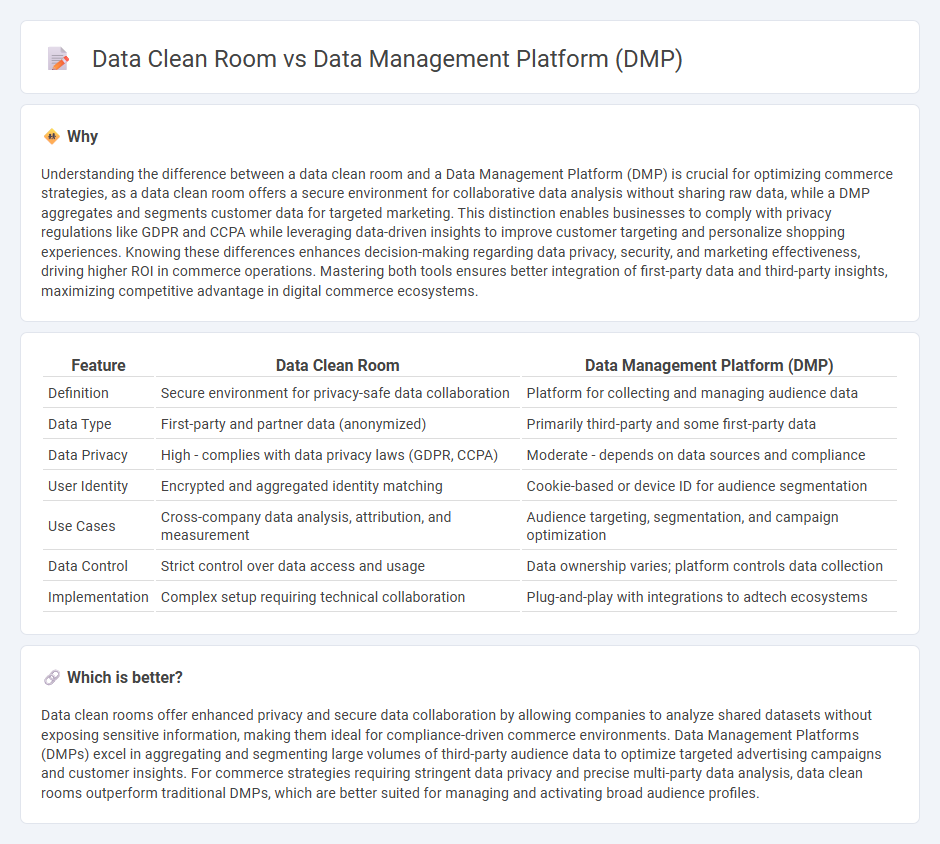
Data Clean Rooms enable secure data collaboration by allowing multiple parties to analyze combined datasets without exposing individual user information, ensuring privacy compliance in commerce analytics. Data Management Platforms (DMPs) aggregate and organize consumer data from various sources to create detailed audience segments for targeted marketing campaigns. Explore how leveraging Data Clean Rooms versus DMPs can enhance your commerce data strategy.
Why it is important
Understanding the difference between a data clean room and a Data Management Platform (DMP) is crucial for optimizing commerce strategies, as a data clean room offers a secure environment for collaborative data analysis without sharing raw data, while a DMP aggregates and segments customer data for targeted marketing. This distinction enables businesses to comply with privacy regulations like GDPR and CCPA while leveraging data-driven insights to improve customer targeting and personalize shopping experiences. Knowing these differences enhances decision-making regarding data privacy, security, and marketing effectiveness, driving higher ROI in commerce operations. Mastering both tools ensures better integration of first-party data and third-party insights, maximizing competitive advantage in digital commerce ecosystems.
Comparison Table
| Feature | Data Clean Room | Data Management Platform (DMP) |
|---|---|---|
| Definition | Secure environment for privacy-safe data collaboration | Platform for collecting and managing audience data |
| Data Type | First-party and partner data (anonymized) | Primarily third-party and some first-party data |
| Data Privacy | High - complies with data privacy laws (GDPR, CCPA) | Moderate - depends on data sources and compliance |
| User Identity | Encrypted and aggregated identity matching | Cookie-based or device ID for audience segmentation |
| Use Cases | Cross-company data analysis, attribution, and measurement | Audience targeting, segmentation, and campaign optimization |
| Data Control | Strict control over data access and usage | Data ownership varies; platform controls data collection |
| Implementation | Complex setup requiring technical collaboration | Plug-and-play with integrations to adtech ecosystems |
Which is better?
Data clean rooms offer enhanced privacy and secure data collaboration by allowing companies to analyze shared datasets without exposing sensitive information, making them ideal for compliance-driven commerce environments. Data Management Platforms (DMPs) excel in aggregating and segmenting large volumes of third-party audience data to optimize targeted advertising campaigns and customer insights. For commerce strategies requiring stringent data privacy and precise multi-party data analysis, data clean rooms outperform traditional DMPs, which are better suited for managing and activating broad audience profiles.
Connection
Data clean rooms and Data Management Platforms (DMPs) are interconnected through their shared focus on secure and privacy-compliant data collaboration and integration. Data clean rooms enable multiple parties to analyze and combine customer data without directly sharing personally identifiable information, while DMPs aggregate and organize audience data from various sources to optimize targeting and personalization. Together, they enhance data-driven commerce by ensuring accurate audience insights and compliance with data privacy regulations.
Key Terms
Audience Segmentation
Data Management Platforms (DMPs) aggregate and analyze third-party data to create detailed audience segments for targeted advertising, relying heavily on cookies and device IDs for tracking user behavior. Data clean rooms offer a privacy-compliant environment where multiple parties can collaborate on audience segmentation using encrypted, first-party data without exposing personally identifiable information (PII). Explore how integrating both solutions can enhance audience insights while maintaining data privacy standards.
Data Privacy
A Data Management Platform (DMP) collects, organizes, and activates first-, second-, and third-party data for targeted advertising, relying heavily on cookies and identifiers, which raises privacy concerns under regulations like GDPR and CCPA. Data clean rooms enable multiple parties to collaborate on aggregated, anonymized data without exposing personally identifiable information (PII), ensuring compliance with data privacy laws while preserving data utility. Explore how these technologies balance data-driven marketing with stringent privacy standards to enhance your data strategy.
Identity Resolution
Data Management Platforms (DMPs) aggregate and organize anonymous customer data for targeted advertising, relying heavily on third-party cookies which limits precise identity resolution. Data clean rooms enable secure collaboration and analysis of first-party data from multiple sources without sharing raw data, enhancing identity resolution through encrypted and privacy-compliant matching techniques. Explore how combining DMPs with data clean rooms can revolutionize your identity resolution strategy and optimize marketing outcomes.
Source and External Links
What is a data management platform? - A Data Management Platform (DMP) is a SaaS platform that collects, organizes, and activates anonymous data from online, offline, and mobile sources to support personalization, marketing, and advertising campaigns by consolidating disparate first-, second-, and third-party data and building audience segments for use across multiple channels.
What Is a Data Management Platform (DMP)? - A DMP collects, organizes, and activates first-, second-, and third-party audience data from various channels to create anonymized customer profiles that enhance targeted advertising and personalization, serving as a backbone for digital marketing efforts to better understand and reach customers.
Data management platform - Wikipedia - A DMP is a software platform used to collect, manage, and analyze large datasets from various sources to identify audience segments for targeted online advertising, often employing big data and AI techniques, while balancing benefits in data organization and marketing insight with privacy concerns.
 dowidth.com
dowidth.com